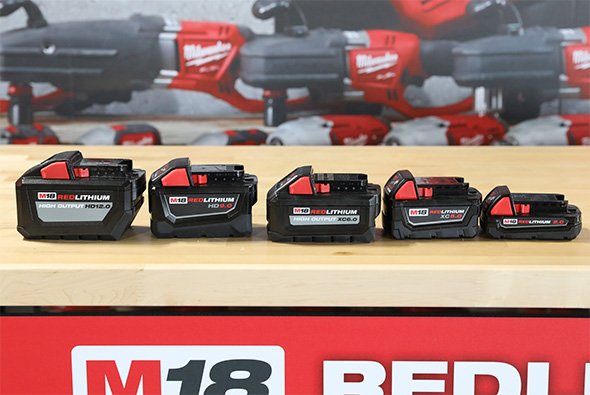
If you buy something through our links, ToolGuyd might earn an affiliate commission.
Cordless power tool batteries used to be simple and easy to understand, where the higher the number, the greater the charge capacity and runtime.
Now, things are a bit more complicated, especially with the introduction of new battery technologies, such as Milwaukee’s Forge.
Here, I’ll quickly classify all current Milwaukee M18 cordless power tool batteries, and provide context and background information I hope you find helpful and convenient.
Milwaukee M18 Battery Sizes

Milwaukee has three main M18 battery size form factors, CP, XC, and HD.
CP – Compact
XC – Extended Capacity
HD – High Demand
Prior to the introduction of the new Forge pouch cell battery, M18 batteries where characterized by the number of Li-ion cells they contained. CP batteries had (5) cylindrical Li-ion cells, XC batteries had (10), and HD had (15).
Now, especially with the new Forge XC 6Ah battery featuring Li-ion pouch cells, the XC descriptor refers to the sizing category.
CP, XC, and HD can roughly describe battery power output and performance expectations as well, but not as accurately as they used to.
Because of this, I think that these labels should only be used to classify M18 batteries according to size and weight.
CP -> Compact (and Light)
XC -> Medium
HD -> Large
Milwaukee M18 Battery Power Scale

Milwaukee recently introduced a Power Scale with 4 different tiers. These tiers preceded the introduction of their M18 Forge battery; this is a new and more elegant presentation of existing tiering.
The higher the power scale level, the greater the potential output and performance delivery of a battery. Generally, the more power a battery can deliver, the cooler and longer it can operate under heavily loads.
Milwaukee has not (yet?) published power level requirements for their M18 cordless power tools. All of their batteries fit all of their tools, but there are more and less ideal pairings.
Based on my familiarity with Milwaukee M18 cordless power tool batteries, I would classify all of the current M18 batteries as follows.
Power Level 1
CP 1.5Ah
CP 2.0Ah
Power Level 2
CP 3.0AH – High Output
CP 4.0Ah – High Output
XC 3.0Ah
XC 4.0Ah
XC 5.0Ah
Power Level 3
XC 6.0Ah – High Output
XC 8.0Ah – High Output
Power Level 4
XC 6.0Ah – Forge
HD 12.0Ah – High Output
Does that make sense? Following is a look at where this all comes from.
Where the M18 Battery Power Levels Come From
As I mentioned above, Milwaukee’s different M18 battery power levels are not entirely new, it’s just that we’re talking about it in a new way.
For that matter, Milwaukee hasn’t exactly discussed the different power levels either; I found the diagram in their Forge battery product listing, and consider it clear enough to reframe how we talk about cordless power tool batteries.
The First M18 RedLithium Batteries
Around 10 years ago, there were CP and XC batteries. Technically, there were compact and XC batteries, as Milwaukee’s CP terminology didn’t appear until much later.
Here is what the power levels looked like towards the end of this age of M18 battery tech.
Power Level 1
CP 1.5Ah
CP 2.0Ah
Power Level 2
XC 3.0Ah
XC 4.0Ah
XC 5.0Ah
HD Batteries
Milwaukee introduced their M18 High Demand 9.0Ah battery in 2015, along with an XC 6Ah battery (not High Output or Forge).
With the High Demand (HD) 9.0Ah battery, a new power level was created. At the time, the CP batteries had 5 Li-ion cells, the XC batteries had 10 Li-ion cells, and the HD battery had 15 Li-ion cells.
Because of how the tools featured common battery technologies, CP, XC, and HD could be used to describe the batteries’ physical sizes, as well as their power output capabilities.
Power Level 2
XC 6.0Ah
Power Level 3
HD 9.0Ah
Both of these batteries have since been discontinued.
High Output Batteries
Milwaukee debuted their first M18 High Output batteries in 2018.
While the earlier CP and XC batteries delivered Power Levels 1 and 2, respectively, the High Output CP and XC batteries are classified in Power Levels 2 and 3 instead.
The new High Output HD battery created another new higher power level.
Power Level 2
CP 3.0AH – High Output
CP 4.0Ah – High Output
Power Level 3
XC 6.0Ah – High Output
XC 8.0Ah – High Output
Power Level 4
HD 12.0Ah – High Output
Milwaukee RedLithium?
Milwaukee updated their M12 and M18 Li-ion cordless power tool batteries in 2010 (here’s our post from the time), with the then-new RedLithium batteries delivering longer runtime, more power, and more charging cycles than their earlier generation batteries. The RedLithium batteries also operated in a wider temperature range.
All of Milwaukee’s M18 batteries since then feature RedLithium branding.
Milwaukee High Output

Milwaukee’s earlier M18 batteries were engineered with 18650-sized Li-ion cells.
With cylindrical cells, the first two digits represent the cell diameter, and the second two represent their length. An 18650 cell has a cylindrical shape with nominal dimensions of 18mm in diameter and 65mm in length.
With M18 High Output (HO), Milwaukee introduced batteries that were engineered with 21700-sized Li-ion cells.
21700 Li-ion cells are physically larger than 18650 cells.
Let’s say you have an 18650 cell with 3.0Ah charge capacity, and a 21700 cell with 3.0Ah charge capacity. Generally speaking, both cells should deliver the same runtime in light duty applications. However, the 21700 cell will have lower charge density and should operate cooler. This allows it to deliver higher power levels than the smaller-sized cell, and for longer.
Looking at battery datasheets to further the point, the maximum continuous discharge current for Samsung’s 18650 3.0Ah battery cell (INR18650-30Q) is 15A at 25°C, and for their 21700 3.0Ah battery (INR27100-30T) it’s 35A at 25°C.
The takeaway is that Milwaukee’s M18 High Output batteries can deliver greater power than non-HO batteries with the same cell count.
For example, a High Output CP 3.0Ah battery, engineered with 5x 21700 Li-ion cells, should deliver higher power than a CP 2.0Ah battery, and match the performance output level of their XC 3.0Ah, 4.0Ah, or 5.0Ah batteries.
What About Milwaukee Forge?

Milwaukee says that their new M18 Forge XC 6.0Ah battery can deliver the same power level as their High Output HD 12.0Ah battery.
Therefore, this battery has an XC size, and is classified in the Power Level 4 tier.
What About Runtime?
An amp-hour is a measure of charge capacity – it’s the number of hours a battery can deliver a constant current of one amp.
A fully-charged 5.0Ah battery can deliver a 1.0A current for up to 5 hours, a 2.5A current for up to 2 hours, a 5.0A current for up to 1 hour, and so forth.
When comparing batteries of the same voltage you can go by amp-hour. When comparing batteries across voltages, go by watt-hours (volts x amp-hours), which is a measure of energy storage capacity.
An M18 5.0Ah battery (90 watt-hours) will power a low-drain cordless power tool for longer than a 3.0Ah (54 watt-hours) battery.
Quick Milwaukee M18 Battery Legend
Based on all of this:
Size and Weight Classes
CP = compact and light
XC = medium size and weight
HD = larger size and heavier weight
Power Classes
Light Duty Batteries (PWR1): CP
Medium Duty Batteries (PWR2): CP-HO, XC
Heavier Duty Battery Choices (PWR3): XC-HO
Highest Duty Battery Choices (PWR4): XC-Forge, HD-HO
How do You Choose the Best M18 Battery?
It’s usually a good idea to start by checking to see which batteries a particular tool might be kitted with. For instance, if Milwaukee bundles a particular M18 tool with a High Output XC 8.0Ah battery in a kit, you should probably look at that battery, or perhaps others in power levels 3 or 4.
I would say that the XC batteries offer a balance between size, weight, and performance, and they span 3 out of 4 of the different power levels.
You can choose an XC battery based on size, power, or cost, and then down to CP or up to HD depending on the tool or your needs and preferences.
Unfortunately, as with most other brands’ cordless power tool lines, Milwaukee’s M18 tools are not divided by power levels. I think we might see this change at some point.
Questions?
I hope this helped demystify Milwaukee’s M18 battery sizes. It’s not an easy topic – please let me know if you have any questions!
See also:
Milwaukee M18 Cordless Power Tool Battery Sizes Explained
Comparing Power Tool Battery Specs – Watt-Hours vs Amp-Hours
Revisiting What an Amp-Hour Means for Cordless Power Tool Batteries






